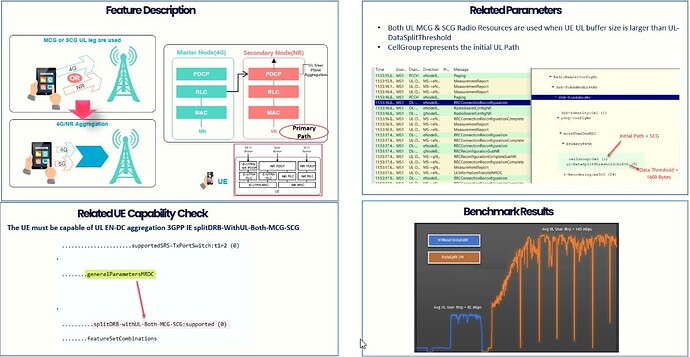(1) Description:
- LTE-NR Uplink Aggregation allows simultaneous uplink data transfer from the User Equipment (UE) to both the Master Cell Group (MCG) and the Secondary Cell Group (SCG).
- Uplink EN-DC aggregation is enabled for capable UEs when the amount of buffered uplink data is more than a controlled UL Data Split Threshold (UL-DataSplitThreshold).
- To Use uplink user plane aggregation, the UE must be capable of UL EN-DC aggregation 3GPP IE splitDRB-WithUL-Both-MCG-SCG
- DL & UL User plane aggregation can be used in combination with UL Carrier aggregation(on MAC & L1 Layer), as the two functions are independent
- The decision is made by the UE, depending on the amount of data in the UL PDCP Buffer.
- If splitDRB-withUL-Both-MCG-SCG is not supported by UE, the UL-DataSplitThreshold included in SgNB Addition Request Ack or RRC Reconfiguration message is set to infinity.
(2) How to verify Feature functionality from Field testing and OSS KPIs?
- Verify UE support for UL Data Split in the UE Capability message, specifically looking at splitDRB-withUL-Both-MCG-SCG under general parameters for MRDC.
- Check the UL Datasplit feature related thrsholds (UL-DataSplitThreshold) and the current Cell Group(Primary path) where Cell Group 1 = SCG and 0 = MCG, this information can be obtained from either SgNB Addition Request Ack or RRC Reconfiguration during SgNB Addition or handover.
- Evaluate the Data Split ratio in the UL using relevant KPIs and assess UL ENDC e-NB data volume to verify feature functionality .
Gain:
- LTE-NR Uplink Data-Split (Aggregation) can improve uplink user throughput and make the performance more robust by reducing the overall uplink user throughput variations. It can potentially also improve eNB/gNB load balancing.
Source: 3GPP TS 37.340
LinkedIn: ![]()
